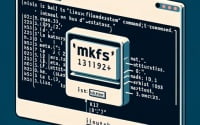Intro to ‘make’ Linux Command: Installation and Usage

Are you trying to compile a program from source code in Linux but feel a bit lost? For many, especially those new to Linux, installing commands can seem a bit daunting. However, the ‘make’ command, like a master builder, simplifies the process of building executable programs and libraries from source code. The ‘make’ command is worth learning to install and use and the process is straightforward once you know the steps.
In this guide, we will walk you through the process of installing and using the ‘make’ command in Linux. We will cover methods for APT-based distributions like Debian and Ubuntu, as well as YUM-based distributions like CentOS and AlmaLinux. We’ll also delve into more advanced topics like compiling from source and installing a specific version of ‘make’. Finally, we will provide guidance on how to use the ‘make’ command and verify that the correct version is installed.
So, let’s get started and master the installation and usage of the ‘make’ command in Linux!
TL;DR: How Do I Install and Use the ‘make’ Command in Linux?
In most Linux distributions, the ‘make’ command comes pre-installed. If it’s not, you can install it in Debian based distributions like Ubuntu, by running the command
sudo apt-get install make. For RPM-based distributions like CentOS, you would run the commandsudo yum install make.
# For Debian based distributions like Ubuntu
sudo apt-get install make
# For RPM based distributions like CentOS
sudo yum install make
# Output:
# Reading package lists... Done
# Building dependency tree
# Reading state information... Done
# make is already the newest version (4.1-9.1ubuntu1).
# 0 upgraded, 0 newly installed, 0 to remove and 0 not upgraded.
This command will install the ‘make’ command on your Linux system. The output indicates that the ‘make’ command is already installed and is the newest version. If it wasn’t installed, the command would install it.
This is a basic way to install the ‘make’ command in Linux, but there’s much more to learn about installing and using ‘make’. Continue reading for more detailed information and advanced usage scenarios.
Table of Contents
- Understanding and Installing the ‘make’ Command in Linux
- Installing ‘make’ Command from Source Code
- Installing Different Versions of ‘make’
- Basic Usage of ‘make’ Command
- Compiling Programs in Linux: Alternative Approaches
- Choosing the Right Tool
- Troubleshooting Common ‘make’ Issues
- The Fundamentals of Compiling Programs in Linux
- The ‘make’ Command: Beyond Basic Use
- Wrapping Up: Installing the ‘make’ Command in Linux
Understanding and Installing the ‘make’ Command in Linux
The ‘make’ command is a build automation tool that automatically builds executable programs and libraries from source code by reading files called Makefiles which specify how to derive the target program. The ‘make’ command is a key tool in the Linux world, used extensively in programming to manage and automate the compilation of source code.
Now, let’s delve into how to install the ‘make’ command in Linux using different package managers.
Installing ‘make’ with APT
Debian-based distributions like Ubuntu use the APT package management system. You can install ‘make’ with the following command:
sudo apt update
sudo apt install make
# Output:
# Reading package lists... Done
# Building dependency tree
# Reading state information... Done
# The following additional packages will be installed:
# make-guile
# Suggested packages:
# make-doc
# The following NEW packages will be installed:
# make make-guile
# 0 upgraded, 2 newly installed, 0 to remove and 0 not upgraded.
# Need to get 378 kB of archives.
# After this operation, 1,176 kB of additional disk space will be used.
The sudo apt update command updates your package lists to ensure you’re getting the latest versions and dependencies. The sudo apt install make command installs ‘make’. The output informs you about the installation process, including any additional packages that were installed.
Installing ‘make’ with YUM
For RPM-based distributions like CentOS, you would use the YUM package manager. The command to install ‘make’ is:
sudo yum install make
# Output:
# Loaded plugins: fastestmirror, ovl
# Loading mirror speeds from cached hostfile
# * base: mirror.its.sfu.ca
# * extras: mirror.its.sfu.ca
# * updates: mirror.its.sfu.ca
# Resolving Dependencies
# --> Running transaction check
# ---> Package make.x86_64 1:3.82-24.el7 will be installed
# --> Finished Dependency Resolution
This command will install the ‘make’ command on your Linux system using the YUM package manager. The output provides details about the installation process, including the specific version of ‘make’ that will be installed and any dependencies that are resolved.
Installing ‘make’ Command from Source Code
If you want to install ‘make’ from source code, you can do so by following these steps:
First, download the source code from the GNU ‘make’ project’s official website. You can use the wget command to download the source code. Then, extract the downloaded file using the tar command.
wget http://ftp.gnu.org/gnu/make/make-4.2.1.tar.gz
tar -xvzf make-4.2.1.tar.gz
# Output:
# make-4.2.1/
# make-4.2.1/README
# make-4.2.1/Makefile.am
# ...
Next, navigate to the extracted folder and compile the source code using the ./configure and make commands. Finally, install ‘make’ using the make install command.
cd make-4.2.1/
./configure
make
sudo ./make install
# Output:
# Making install in glob
# make[1]: Entering directory '/home/user/make-4.2.1/glob'
# ...
The configure script works by identifying the proper values for system-dependent variables used while compiling. It then uses those values to create a ‘Makefile’, allowing you to then run the make command. Running make by itself will fail since there is no ‘Makefile’, or install target, until you run configure.
some systems will not be able to run make properly until completely installed. For those systems, you can use the script
build.shinstead.
To do this, first run configure as normal. Then, instead of typing make, type sh build.sh. This will compile the program in the current directory. Then you will have a ‘make’ program that you can use for ./make install.
If you encounter an error such as cannot open ./build.cfg: No such file, when trying to run sh build.sh, may need to append --prefix=/usr/local to the ./configure statement. This will place the installed components into a previously-empty folder, and properly structure them once you run make install.
Here’s an example:
cd make-4.2.1/
./configure --prefix=/usr/local
sh build.sh
sudo ./make install
Installing Different Versions of ‘make’
There are different versions of ‘make’ available, and the version you need might depend on the specific features or compatibility with other software. Here’s how you can install specific versions of ‘make’ from source and using package managers.
Installing Specific Versions from Source
To install a specific version from source, you can download the source code for that version from the GNU ‘make’ project’s official website. The process is the same as installing ‘make’ from source, but you have to specify the version in the wget command.
wget http://ftp.gnu.org/gnu/make/make-3.82.tar.gz
tar -xvzf make-3.82.tar.gz
cd make-3.82/
./configure
make
sudo make install
# Output:
# Making install in glob
# make[1]: Entering directory '/home/user/make-3.82/glob'
# ...
Just as before, if you have issues running make to compile the source code. You can use sh build.sh instead.
Here’s an example:
cd make-3.82/
./configure --prefix=/usr/local
sh build.sh
sudo ./make install
Installing Specific Versions with APT and YUM
To install a specific version of ‘make’ using APT or YUM, you can specify the version in the install command. However, the availability of specific versions might depend on the repositories configured on your system.
# For APT
sudo apt-get install make=4.1-9.1ubuntu1
# For YUM
sudo yum install make-3.82
# Output:
# Reading package lists... Done
# Building dependency tree
# Reading state information... Done
# make is already the newest version (4.1-9.1ubuntu1).
# 0 upgraded, 0 newly installed, 0 to remove and 0 not upgraded.
The output informs you about the installation process and whether the specified version was installed or if it was already installed.
| Version | Key Features | Compatibility |
|---|---|---|
| 3.82 | Basic features, stable | Older systems |
| 4.1 | Improved features, performance enhancements | Newer systems |
| 4.2.1 | Latest features, bug fixes | Latest systems |
Basic Usage of ‘make’ Command
Once you’ve installed the ‘make’ command, you can verify its installation by checking its version. You can also compile a simple program using a Makefile to test its functionality.
Verifying ‘make’ Installation
You can verify the installation of ‘make’ by checking its version using the make --version command.
make --version
# Output:
# GNU Make 4.1
# Built for x86_64-pc-linux-gnu
# Copyright (C) 1988-2014 Free Software Foundation, Inc.
# License GPLv3+: GNU GPL version 3 or later <http://gnu.org/licenses/gpl.html>
# This is free software: you are free to change and redistribute it.
# There is NO WARRANTY, to the extent permitted by law.
The output provides information about the installed version of ‘make’, the system it’s built for, and the license information.
Using ‘make’ Command
To use the ‘make’ command, you need a Makefile which specifies how to derive the target program. Let’s create a simple C program and a Makefile to compile it.
echo -e '#include <stdio.h>
int main() {
printf("Hello, World!
");
return 0;
}' > hello.c
echo -e 'all:
gcc hello.c -o hello' > Makefile
make
# Output:
# gcc hello.c -o hello
This creates a simple C program that prints ‘Hello, World!’ and a Makefile that compiles it using the ‘gcc’ compiler. The make command reads the Makefile and compiles the program. The output shows the command used to compile the program.
You can run the compiled program using the ./hello command.
./hello
# Output:
# Hello, World !
The output shows the message printed by the program. This verifies that the ‘make’ command is working correctly and can compile programs from source code.
Compiling Programs in Linux: Alternative Approaches
While the ‘make’ command is a powerful tool for compiling programs in Linux, it’s not the only method available. There are alternative approaches, each with its own set of advantages and disadvantages. Let’s explore some of these alternatives and understand when and why you might choose to use them.
Direct Compilation Using GCC
The GNU Compiler Collection (GCC) is a set of compilers produced by the GNU Project. It’s possible to compile programs directly using GCC, bypassing the ‘make’ command entirely. Here’s an example of how to compile a simple C program using GCC directly:
echo -e '#include <stdio.h>
int main() {
printf("Hello, World!
");
return 0;
}' > hello.c
gcc hello.c -o hello
# Output:
# No output if compilation is successful.
In this example, we’re creating a simple C program that prints ‘Hello, World!’, and then compiling it directly using the gcc command. If the compilation is successful, there will be no output.
Running the compiled program will produce the following output:
./hello
# Output:
# Hello, World!
The advantage of this approach is its simplicity. You’re directly invoking the compiler and explicitly stating what you want it to do. However, the downside is that it doesn’t scale well. For larger projects with multiple source files and dependencies, using ‘make’ is more efficient.
Using Other Build Automation Tools
There are also other build automation tools available, such as CMake and Ninja, which offer additional features and capabilities beyond ‘make’. These tools can handle more complex build systems and offer more control and flexibility.
Choosing the Right Tool
The choice of tool depends on the complexity of your project, the features you need, and your personal preference. For simple projects, direct compilation using GCC might be sufficient. For larger projects with multiple source files and dependencies, ‘make’ is a powerful and efficient tool. If you need additional features and capabilities, consider using a more advanced build automation tool like CMake or Ninja.
Remember, the most important thing is to choose a tool that fits your needs and helps you achieve your goals in the most efficient way possible.
Troubleshooting Common ‘make’ Issues
While using the ‘make’ command, you might encounter some common issues. Let’s discuss these potential problems and their solutions.
‘make’ Command Not Found
One of the most common issues is the ‘make: command not found’ error. This error occurs when the ‘make’ command is not installed on your system or the system can’t locate it. To resolve this, you need to install ‘make’ using the appropriate package manager for your distribution (as we discussed earlier). Alternatively, if ‘make’ is installed but not found, you might need to add it to your PATH.
make
# Output:
# bash: make: command not found
If you see this error, it means that the ‘make’ command is not installed or not found on your system. You can resolve this by installing ‘make’ or adding it to your PATH.
Errors in the Makefile
If there are errors in your Makefile, the ‘make’ command might fail to compile your program. These errors could be due to syntax mistakes, missing dependencies, or incorrect paths. It’s important to carefully check your Makefile for any errors and correct them.
make
# Output:
# make: *** No targets specified and no makefile found. Stop.
This error indicates that ‘make’ couldn’t find a Makefile or any targets specified. You can resolve this by providing a Makefile or specifying the targets.
Version Incompatibilities
Sometimes, you might encounter issues due to version incompatibilities. For example, a Makefile written for a newer version of ‘make’ might not work correctly with an older version. In such cases, you might need to update ‘make’ to a newer version or modify the Makefile to be compatible with the older version.
make
# Output:
# make: *** [Makefile:2: all] Error 2
This error indicates that there was an error in the Makefile. You can resolve this by checking the Makefile for any syntax errors or version incompatibilities.
Remember, troubleshooting is a key part of working with any command in Linux. Understanding the potential issues and their solutions can help you use the ‘make’ command more effectively.
The Fundamentals of Compiling Programs in Linux
Before diving into the specifics of the ‘make’ command, it’s important to understand the basics of compiling programs in Linux. This knowledge will provide a solid foundation for understanding the role of ‘make’ and how it fits into the broader picture of Linux programming.
The Role of Compilers in Programming
A compiler is a special program that processes statements written in a particular programming language and turns them into machine language or ‘code’ that a computer’s processor uses. Essentially, compilers take human-readable and human-writeable code and convert it into code that machines can understand.
# Write a simple C program
echo -e '#include <stdio.h>
int main() {
printf("Hello, World!
");
return 0;
}' > hello.c
# Compile it with GCC
gcc hello.c -o hello
# Output:
# No output if compilation is successful.
In this example, we write a simple C program and then compile it using the GNU Compiler Collection (GCC). If the compilation is successful, there is no output. This is a basic demonstration of how a compiler works.
The ‘make’ Command and the Compilation Process
In a large software project, compilation can be complex. The codebase may consist of hundreds or even thousands of files. Compiling these files individually would be time-consuming and error-prone. This is where the ‘make’ command comes in.
The ‘make’ command automates the compilation process. It uses a file called a Makefile that contains rules describing how to derive the executable program from the source code files. When ‘make’ is run, it reads the Makefile, determines which parts of the program need to be recompiled, and issues the commands to recompile them.
# Write a simple Makefile for our C program
echo -e 'all:
gcc hello.c -o hello' > Makefile
# Use 'make' to compile the program
make
# Output:
# gcc hello.c -o hello
In this example, we write a simple Makefile for our C program and then use the ‘make’ command to compile it. The output shows the command used to compile the program, demonstrating how ‘make’ automates the compilation process.
In essence, the ‘make’ command is a powerful tool that simplifies the compilation process in Linux, making it easier to manage large software projects. Understanding how it works and how to use it effectively is a crucial skill in Linux programming.
The ‘make’ Command: Beyond Basic Use
The ‘make’ command is not just a tool for compiling programs; it’s a powerful ally in managing larger programming projects. It plays a crucial role in automating the build process, making it easier to handle complex projects with multiple source files and dependencies.
The ‘make’ Command in Large Projects
In a large project, you may have hundreds or even thousands of source files. Manually compiling these files would be a Herculean task. However, with the ‘make’ command, you can automate the entire process.
The ‘make’ command reads a Makefile, determines which parts of the program need to be recompiled, and issues the commands to recompile them. This automation not only saves time but also reduces the likelihood of errors.
# A hypothetical large project with multiple source files
ls
# Output:
# main.c module1.c module2.c module3.c Makefile
# Use 'make' to compile the program
make
# Output:
# gcc -c main.c
# gcc -c module1.c
# gcc -c module2.c
# gcc -c module3.c
# gcc -o program main.o module1.o module2.o module3.o
In this hypothetical example, we have a large project with multiple source files and a Makefile. When we run the ‘make’ command, it compiles each source file and then links them to create the final executable program. This demonstrates how ‘make’ can simplify the management of large projects.
Exploring Related Concepts: Makefiles and Automated Build Systems
To fully leverage the power of the ‘make’ command, it’s worthwhile to delve deeper into related concepts like Makefiles and automated build systems.
A Makefile is a file that contains rules for how to derive the target program from the source code. It’s the blueprint that ‘make’ follows when compiling a program. Understanding how to write and use Makefiles is key to using ‘make’ effectively.
Automated build systems are tools or frameworks that automate tasks like code compilation and linking, dependency management, testing, and deployment. The ‘make’ command is a fundamental part of many automated build systems, and understanding how it works can provide insight into these larger systems.
Further Resources for Mastering ‘make’ Command
To further your understanding of the ‘make’ command, consider exploring these additional resources:
- GNU ‘make’ Manual: This is the official manual for ‘make’ from the GNU Project. It’s a comprehensive resource that covers everything from basic usage to advanced features.
Managing Projects with GNU ‘make’: This book from O’Reilly Media provides a thorough introduction to ‘make’ and its usage. It covers topics like writing Makefiles, managing large projects, and using ‘make’ with different programming languages.
Autotools: A Practitioner’s Guide to Autoconf, Automake and Libtool: This guide provides a deep dive into the Autotools system, of which ‘make’ is a part. It’s a great resource for understanding how ‘make’ fits into larger build systems.
By exploring these resources and putting what you learn into practice, you can master the ‘make’ command and enhance your proficiency in Linux programming.
Wrapping Up: Installing the ‘make’ Command in Linux
In this comprehensive guide, we’ve delved into the depths of installing and using the ‘make’ command in Linux. This powerful tool, a cornerstone of Linux programming, helps simplify the process of building executable programs and libraries from source code.
We kicked off with the basics, explaining how to install the ‘make’ command using different package managers like APT and YUM. We then delved into more advanced territory, exploring how to install ‘make’ from source code and handle specific versions of ‘make’. Along the way, we tackled common issues you might encounter when using ‘make’ and provided solutions to help you overcome these challenges.
We also explored alternative approaches to compiling programs in Linux, such as direct compilation using GCC and using other build automation tools like CMake and Ninja. Here’s a quick comparison of these methods:
| Method | Pros | Cons |
|---|---|---|
| ‘make’ | Powerful, efficient for large projects | May require troubleshooting for complex Makefiles |
| Direct Compilation Using GCC | Simple, direct control | Doesn’t scale well for large projects |
| Other Build Automation Tools | Advanced features, more control | Might be overkill for simple projects |
Whether you’re just starting out with the ‘make’ command or looking to level up your Linux programming skills, we hope this guide has given you a deeper understanding of the ‘make’ command and its capabilities.
With its balance of power and efficiency, the ‘make’ command is a key tool for compiling programs in Linux. Happy programming!


